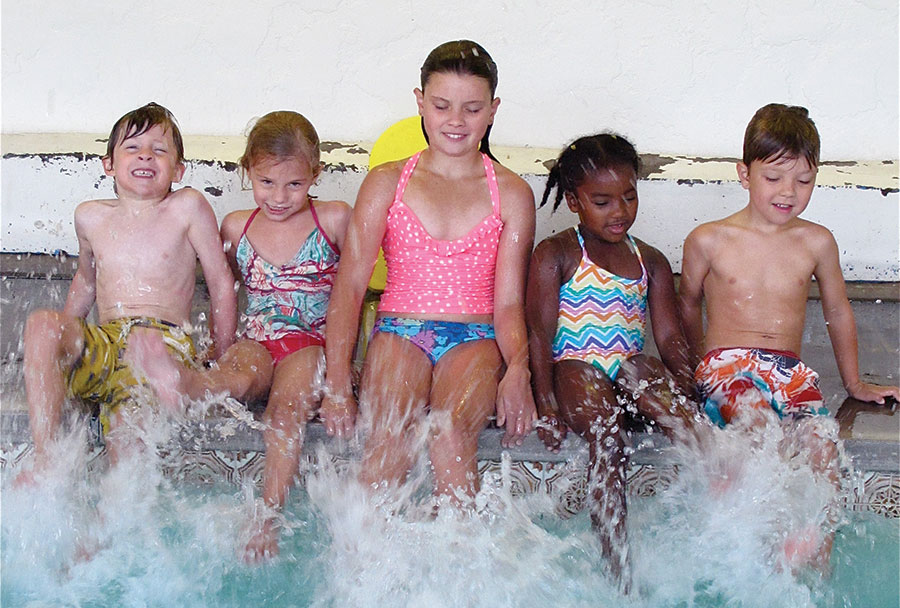The American Red Cross estimates that over 90% of families spend at least some time in the water during the summer months, so it makes sense that summer is the prime season for children’s swim lessons. But don’t be so quick to pull your kids out of the water just because the temperature outside has fallen.
“I’m a big proponent of year-round swimming at least until it becomes like riding a bike,” says Ruthie Zarren, a certified swim instructor and water safety educator. “Being in the water and swimming safely should be second nature for every child, but kids are rarely able to develop the skills they need when they only spend a few months of the year in the water.”
Surprised that now might be the right time to sign your child up for swim lessons? Consider the following ways in which kids can benefit when they keep swimming throughout the winter season:
Winter swim lessons build the skills kids need to stay safe in the water.
Swimming is a life skill – and an important one in the North State, which offers an array of swimming pools, lakes and other bodies of water, says Shelly Kuntz, aquatics coordinator at Shasta Family YMCA in Redding. “You find mountains with streams, rivers and lakes. There’s water everywhere you go,” she says.
According to a 2009 study from the Archives of Pediatrics and Adolescent Medicine, formal swim lessons can significantly reduce the risk of drowning, particularly in children between the ages of 1 and 4. And while summer classes certainly help to build the strong swimming and water safety skills kids need, year-round lessons allow them to better retain those skills – and move on to mastering more advanced skills faster.
“I like to use the analogy of playing an instrument,” says aquatics director Kyle Fetick, of Missouri. “You wouldn’t expect to take piano for a few months out of the year and be a proficient pianist. Swimming is very much the same. While it may be a typical summertime activity, the more you learn in the winter and the spring, the more prepared you are to be a confident and safe swimmer during the summer.”
Kuntz adds that because fewer children tend to enroll in winter lessons than summer sessions, the child-to-teacher ratio usually is smaller this time of year. “Lessons become more one-on-one and children progress even faster,” she says. More advanced swimmers can also join a year-round swim team, where Kuntz says they set long-term goals and learn team skills.
Winter swim lessons keep kids active.
The Centers for Disease Control and Prevention recommend that children and adolescents get at least 60 minutes of physical activity each day. But parents often struggle to keep kids active, particularly during the winter months, when colder temperatures and fewer hours of daylight limit outdoor playtime and lead to a more sedentary lifestyle. Weekly swim lessons provide built-in insurance that children are going to get moving (and splashing) on a regular basis.
Swimming works most of the body’s major muscle groups and carries a low risk of injury, making it an excellent form of exercise for growing children. And since swimming is an activity that almost all kids enjoy, they are likely to jump into the pool without protest.
Winter swim lessons can cure cabin fever.
It’s common for children (and adults) to become bored and restless during the long winter months. Indoor activities like reading and playing video games can only provide so many hours of entertainment before kids feel the urge to run and jump and play (and parents begin to feel like they are going to lose their minds.) When it’s too cold to head to the playground, a trip to an indoor pool makes for the perfect escape.
During swim lessons, kids get to expend their excess energy that builds up after too much time spent indoors. They have an opportunity to see their friends, interact with their teachers and move their muscles as much as they need. Once class is over, they should be ready to rest – or at least play quietly – upon returning home.
Bottom line: routine winter swim lessons keep kids moving and also allow them to develop the strong swimming skills needed to stay safe in the water. Maybe even more importantly, they give the entire family a reason to get out of the house – before cabin fever sets in.
[sws_grey_box box_size=”585″]
Where Your Family Can Swim This Winter
There are facilities that offer open swims, swim lessons and swim teams throughout the winter season in Upper California. Besides signing the kids up, when it’s too cold to play outside, an indoor pool is a great place to take the family! Visit these North State Parent online Family Resources pages to find out about winter swimming opportunities: northstateparent.com/Aquatics northstateparent.com/SwimTeams [/sws_grey_box]
Posted in: Community
Comment Policy: All viewpoints are welcome, but comments should remain relevant. Personal attacks, profanity, and aggressive behavior are not allowed. No spam, advertising, or promoting of products/services. Please, only use your real name and limit the amount of links submitted in your comment.
Comments
Leave a Reply
You Might Also Like...
Students Gear Up for Bike to School Day Around the North State
Kids love riding bicycles. Maybe it’s because it’s an outdoor activity, or it’s something they can do with their friends. Maybe it’s because they can actually get somewhere under their […]

In Motion Fitness Embarks on Chico’s Most Ambitious Mural Art Project Ever
In Motion Fitness, a high profile local fitness center in Chico, California, is midway through what will ultimately be the largest outdoor mural art project in Chico history. The larger-than-life […]

Your Local Library is a Hub of Activity
If a library isn’t your idea of the “happening place” in town, it’s time to walk back through the doors of your local branch. Gayle Harrington, Cottonwood’s director of library […]

Teaching Kids About Kindness: Small Gestures to Put Smiles on People’s Faces
Amid our busy lives, it can be easy to lose sight of the little things we can do to make the world a gentler, kinder place for others. As […]




kiyel williams says
I would never have thought of doing swim lessons in the winter. A heated indoor pool sounds like the perfect cure to cabin fever. It could also get the kids out of the house for a while. I will pass this on to my friend so she can decide on getting her kids winter swim lessons. Thank you for the information!